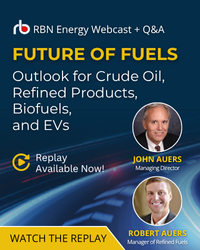U.S. demand for LNG feedgas has picked up in recent weeks, posting a record high of 5.6 Bcf/d in late February and averaging more than 5 Bcf/d in March to date, as Cheniere Energy completed the fifth train at Sabine Pass and the first at Corpus Christi. That level is nearly 1 Bcf/d higher than last month and nearly double what it was at this time last year. But it’s just the start. Train 2 at Corpus Christi was approved for feedgas just yesterday and Kinder Morgan’s Elba Island project in Georgia just days before that. With about 30 MMtpa, or ~4.5 Bcf/d, of liquefaction and export capacity due online this year, feedgas deliveries are poised to surpass 9 Bcf/d by the end of the year, with nearly all of that incremental demand coming online along the Texas and Louisiana Gulf Coast. The pace of this demand growth over the course of the year will come down to how quickly the anticipated trains can complete construction and testing, the timing of which can depend on a whole host of factors, including the extent of the repairs or modifications that are needed along the way, the timing of regulatory approvals, or the timing of gas pipeline connections to supply the facilities. Today, we continue our series examining the status and timing of LNG export projects in 2019.
To get a sense of the timeline, we started in Part 1 with a discussion of the various systems involved in the liquefaction and export process, and what it takes to bring a train online. We then used the example of Train 1 at Cheniere Energy’s Sabine Pass LNG (SPL) terminal, which came online in early 2016, to understand the commissioning stages and how they correlate to the ramp-up of feedgas demand. Based on that timeline and an analysis of the ramp-up activity for subsequent trains at the facility — 2, 3 and 4 so far — we concluded that, at least in Cheniere’s world, it takes approximately 200-224 days from when the commissioning phase kicks off to when the train achieves “substantial completion” (i.e. enters full service).
Among the first steps in the commissioning process — well before any feedgas can be delivered — is to introduce the fuel gas necessary to first power up the gas turbines or electric motors and compressors. From there, the project will usually commission some of the ancillary systems critical to the liquefaction process, such as the gas pre-treatment and heavy hydrocarbon removal units. In fact, we found that the first nominal volumes of feedgas aren’t typically introduced until around Day 60 or so; it takes about another 80-100 days before feedgas volumes approach train capacity and become more consistent, a sign that first LNG production is happening and the first commissioning cargo from the train is imminent. After the first cargo, feedgas flows can again become sporadic or stop completely as intermittent shutdowns are needed to make repairs and modifications. Once those issues are resolved and the facility comes back online, however, feedgas flows tend to be more or less consistent and run near train capacity. Nevertheless, it can still be a while after the first cargo loads before the train becomes fully operational, especially if a subsequent train has begun commissioning by then, as has been the case at SPL and Cheniere’s Corpus Christi Liquefaction project (CCL).
Join Backstage Pass to Read Full Article






